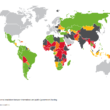COVID-19 and HIV/AIDS prevention
COVID-19 and HIV/AIDS Prevention: Handling Two Pandemics at Once
Global efforts to eradicate HIV/AIDS faced a major hurdle with the introduction of COVID-19. Access to crucial HIV prevention, testing, and treatment services was put at risk by lockdowns, social distancing initiatives, and disruptions to healthcare systems. Thankfully, creative solutions surfaced, proving the HIV/AIDS response’s adaptability to a fresh pandemic.
Table of Contents

Reaction to a Pandemic: Reducing Interruptions
COVID-19 and HIV/AIDS prevention
The pandemic response’s first goal was to minimise disruptions to the HIV/AIDS services that were already in place. This included:
- Preserving Access to Antiretroviral Therapy (ART): It was imperative to guarantee continuous availability of ART for individuals living with HIV (PLWHIA). This included looking into telemedicine consultations for drug renewals, as well as multi-month prescriptions and home pharmaceutical delivery.
- Modifying the Provision of Services: Relocating non-essential HIV services, such as support group gatherings, to online venues assisted in preserving a feeling of support and community.
- Setting Continuity of Care as a Top Priority: Procedures were developed to identify PLWHIA who were at a high risk of COVID-19 problems and make sure patients got the right care.
COVID-19 and HIV/AIDS prevention
By taking these steps, the possible harm that COVID-19 could cause to HIV care and treatment was lessened.
The Revolution in HIV Prevention with Telemedicine
COVID-19 and HIV/AIDS prevention
During the pandemic, telemedicine—the use of telecommunications technology for the delivery of healthcare—became indispensable. Among its advantages for preventing HIV are:
- Enhanced Access to Testing and PrEP: Individuals, particularly those who face geographic obstacles, can now more easily obtain remote HIV testing and counselling thanks to telemedicine consultations.
- Better Support for PrEP Adherence: Online consultations provide medical professionals the ability to keep an eye on patients’ compliance with pre-exposure prophylaxis, or PrEP, and to offer continued assistance to those who are using it to avoid HIV.
- Stigma Reduction: Since telemedicine consultations can be held in private, there may be less stigma attached to receiving HIV-related care.
COVID-19 and HIV/AIDS prevention
Even though telemedicine has many advantages, it’s important to address its drawbacks, such as:
Digital Divide: Some populations may not be able to get telemedicine services because they do not have access to technology or internet connectivity. Initiatives to close this disparity are crucial.
Privacy Issues: In order to maintain patient anonymity during telemedicine consultations, strong data security mechanisms are required.
Measures of Public Health: Increasing Preventive Measures
COVID-19 and HIV/AIDS prevention
The following public health initiatives that were put in place during the epidemic can be used to prevent HIV:
- Increasing Community Involvement: Promoting HIV prevention through community outreach programmes in conjunction with COVID-19 safety precautions can be very successful.
- Harm Reduction Services: One of the most important ways to stop HIV transmission among injection drug users is to maintain access to harm reduction services, such as needle and syringe programmes.
- Sexual Health Education: In the COVID-19 era, programmes that encourage condom use and safe sexual behaviour are still essential for avoiding HIV transmission.
COVID-19 and HIV/AIDS prevention
HIV prevention efforts can be further strengthened by public health authorities by incorporating these measures into more comprehensive pandemic response programmes.
In summary, a combined strategy for a better future
COVID-19 and HIV/AIDS prevention
The COVID-19 pandemic brought attention to the need for adaptive and flexible HIV preventive strategies. Telemedicine provides a way ahead, in conjunction with ongoing support for community-based initiatives and key services. Even in the face of new obstacles, we can guarantee ongoing progress towards an AIDS-free future by carefully incorporating HIV prevention into the broader public health response.


